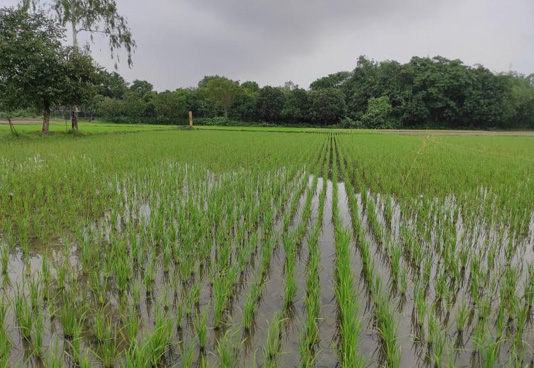By Dr Aynal Haque
RAJSHAHI, July 13, 2020 (BSS)- Ongoing farming of Aush paddy has exceeded target predicting a record production of the food crop in Rajshahi division during the current season despite the present novel coronavirus (COVID-19) pandemic situation.
According to the farmers and DAE officials, the farmers have brought 1,639 hectares more lands under the paddy farming compared to the target set by the Department of Agriculture Extension (DAE) after the best uses of facilities provided by the government.
The DAE has set a target of producing around 7.5 lakh tonnes of Aush rice from 2.52 lakh hectares of land in all eight districts in the division.
But, the farmers cultivated the paddy on around 2.54 lakh hectares of land generating hopes of additional rice production that will ultimately help coping with the Covid-19 pandemic situation.
Sources said government incentives, technological assistance, high yielding seeds, suitable climatic condition, frequent rainfall and satisfactory yield and market price of the newly harvested Boro paddy and rice are being adjudged as the major factors of exceeding the farming target.
Sudhendra Nath Roy, Additional Director of DAE, Rajshahi said the government has adopted diversified steps including incentives and technological support to promote the aush rice farming.
He said the government has provided incentives to 56,265 small and marginalized farming families to encourage them towards aush farming in the division. Each of them was given five kilograms of high yielding seeds, 20 kilograms of diammonium phosphate and ten kilograms of muriate of potash fertilizers.
Apart from this, another 10,900 farmers were given 54,500 kilograms of high yielding seeds to attain the aush production target. Each of the beneficiary farmers was given five kilograms seeds.
Agriculturist Sudhen Roy said the agricultural incentives will help boost aush paddy production as the country’s total production will be enhanced as the government has attached highest priority to the agriculture sector to cope with the present pandemic situation.
He said the Aush farming is very much cost effective as it requires less production cost and faces less natural calamity.
Last year, the farmers produced 5.56 lakh tonnes of Aush rice from around 2.38 lakh hectares of land in Rajshahi division.
Wali Khan, 48, a farmer of Bhatopara village under Godagari Upazila, said he has cultivated Aush paddy on more lands this year than the previous year. He has enhanced his Aush farming as he got good yield and market price of boro paddy.
Mukur Kumar Kuri, 56, another farmer of Shrikhanda village under Tanore Upazila, said he has cultivated the Aush paddy on around three bigha of land this time. He is happy over his present farming condition.
“I got 22 mounds of paddy per bigha through cultivating a high yielding variety on seven bighas of land last year,” said Sultan Ahemd, 49, a farmer of Shahabdipur village under Godagari upazila in the district.
He, however, could get hardly 10 mounds of paddy per bigha if he cultivates Parija, a conventional variety of the region.
Selim Akter, 58, a farmer of Bhobanipur village under Tanore upazila, expressed his happiness over cultivating the high yielding variety saying its average yield is from 15 to 23 mounds per bigha.
Amidst the present glowing climatic condition and frequent rainfall, the farmers in general are now passing their busiest time in nursing the transplanted paddy fields everywhere in the region including its vast Barind tract.
On the other hand, some new high yielding paddy varieties released by Bangladesh Rice Research Institute (BRRI) have opened up a door of enormous prospects of boosting aush rice in the division.
BRRI Chief Scientific Officer Dr Aminul Islam said some of the varieties including the BRRIdhan-48 have gained popularity among farmers in the Barind tract during the last couple of years.
BRRIdhan-48, a short duration and drought tolerant paddy variety for the Aush season, has been giving satisfactory yield with scanty rainfall and limited irrigation in the area.



